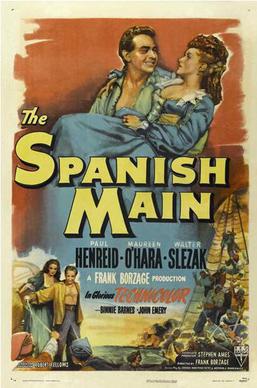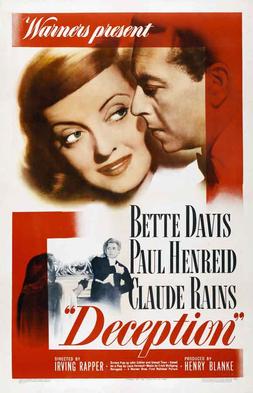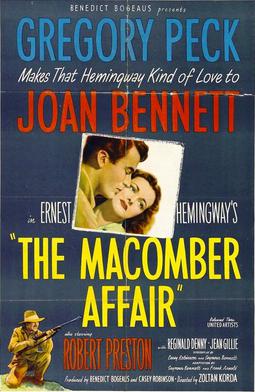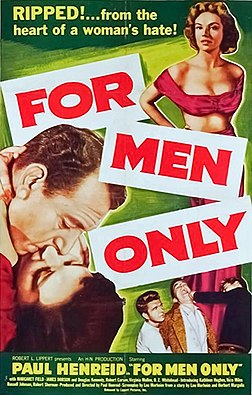
Scarlet Street is a 1945 American film noir directed by Fritz Lang. The screenplay concerns two criminals who take advantage of a middle-aged painter in order to steal his artwork. The film is based on the French novel La Chienne by Georges de La Fouchardière, which had been previously dramatized on stage by André Mouëzy-Éon, and cinematically as La Chienne (1931) by director Jean Renoir.

Paul Henreid was an Austrian-American actor, director, producer, and writer. He is best remembered for several film roles during the Second World War, including Capt. Karl Marsen in Night Train to Munich (1940), Victor Laszlo in Casablanca (1942) and Jerry Durrance in Now, Voyager (1942).

The Big Combo is a 1955 American crime film noir directed by Joseph H. Lewis, written by Philip Yordan and photographed by cinematographer John Alton, with music by David Raksin. The film stars Cornel Wilde, Richard Conte and Brian Donlevy, as well as Jean Wallace, who was Wilde's wife at the time. The supporting cast features Lee Van Cleef, Earl Holliman and the final screen appearance of actress Helen Walker. The Big Combo received positive reviews from critics.
Black Angel is a 1946 American film noir starring Dan Duryea, June Vincent and Peter Lorre. Directed by Roy William Neill, it was his final feature film. Produced by Universal Pictures, it is set in Los Angeles and broadly adapted from Cornell Woolrich's 1943 novel The Black Angel.

House of Dark Shadows is a 1970 American feature-length horror film produced and directed by Dan Curtis, based on his Dark Shadows television series. In this film expansion, vampire Barnabas Collins searches for a cure for vampirism so he can marry a woman who resembles his long-lost fiancée Josette.

Secret Beyond the Door is a 1947 American film noir psychological thriller and a modern updating of the Bluebeard fairytale, directed by Fritz Lang, produced by Lang's Diana Productions, and released by Universal Pictures. The film stars Joan Bennett and was produced by her husband Walter Wanger. The black-and-white film noir drama is about a woman who suspects her new husband, an architect, plans to kill her.

Where Danger Lives is a 1950 American film noir thriller directed by John Farrow and starring Robert Mitchum, Faith Domergue and Claude Rains.

The Spanish Main is a 1945 American adventure film starring Paul Henreid, Maureen O'Hara, Walter Slezak and Binnie Barnes, and directed by Frank Borzage. It was RKO's first all-Technicolor film since Becky Sharp ten years before.

Deception is a 1946 American film noir drama released by Warner Brothers and directed by Irving Rapper. The film is based on the 1927 play Monsieur Lamberthier by Louis Verneuil. The screenplay was written by John Collier and Joseph Than. It stars Bette Davis, Paul Henreid, and Claude Rains, who had also appeared together in the highly successful Now, Voyager (1942), which was also directed by Rapper.

Man Hunt is a 1941 American political thriller film, directed by Fritz Lang and starring Walter Pidgeon and Joan Bennett. It is based on the 1939 novel Rogue Male by Geoffrey Household and is set in Europe just prior to the Second World War. Lang had fled Germany into exile in 1933 and this was the first of his four anti-Nazi films, which include Ministry of Fear, Hangmen Also Die!, and Cloak and Dagger. It was Roddy McDowall's first Hollywood film after escaping London following the Blitz. Man Hunt was one of many films released in 1941 that were considered so pro-British that they influenced neutral members of the U.S. public to sympathize with the British side in World War II.

The Woman on the Beach is a 1947 American film noir directed by Jean Renoir and starring Joan Bennett, Robert Ryan, and Charles Bickford. It was released by RKO Radio Pictures. The film is a love triangle drama about Scott, a conflicted U.S. Coast Guard officer (Ryan), and his pursuit of Peggy, a married woman (Bennett). Peggy is married to Tod, a blind former artist (Bickford).

Joan of Paris is a 1942 war film about five Royal Air Force pilots shot down over Nazi-occupied France during World War II and their attempt to escape to England. It stars Michèle Morgan and Paul Henreid, with Thomas Mitchell, Laird Cregar and May Robson in her last role.

The Macomber Affair is a 1947 American adventure drama film starring Gregory Peck, Joan Bennett, and Robert Preston. Directed by Zoltan Korda and distributed by United Artists, it portrays a fatal love triangle set in British East Africa between a frustrated wife, a weak husband, and the professional hunter who comes between them.

The Man Who Broke the Bank at Monte Carlo is a 1935 American romantic comedy film made by 20th Century Fox. It was directed by Stephen Roberts, and starred Ronald Colman, Joan Bennett, and Colin Clive. The screenplay was written by Nunnally Johnson and Howard Smith, based on a play by Ilya Surgutchoff and Frederick Albert Swan. The film was inspired by the song of the same name popularised by Charles Coborn.

Whiplash is a 1948 American film noir directed by Lewis Seiler. It was written by Harriet Frank Jr. and Maurice Geraghty and adapted by Gordon Kahn, from a story by Kenneth Earl. The film stars Dane Clark, Alexis Smith, Zachary Scott and Eve Arden.

The Third Secret is a 1964 British CinemaScope neo-noir psychological mystery thriller film directed by Charles Crichton, and starring Stephen Boyd, Jack Hawkins, Richard Attenborough, Diane Cilento, Pamela Franklin, Paul Rogers and Alan Webb. The screenplay by Robert L. Joseph focuses on an American newscaster who investigates the mysterious death of his psychoanalyst. According to the film, there are three kinds of secrets; the first, you keep from others; the second, you keep from yourself, and the third is the truth.

Bad for Each Other is a 1953 American drama film noir directed by Irving Rapper and starring Charlton Heston, Lizabeth Scott and Dianne Foster. It was produced and distributed by Columbia Pictures. Its genre has been characterized as a "medical melodrama" with a film noir "bad girl".

A Woman's Devotion is a 1956 American film noir directed by Paul Henreid and starring Ralph Meeker, Janice Rule, Henreid and Rosenda Monteros. It was produced and distributed by Republic Pictures.

For Men Only is a 1952 American film noir directed by Paul Henreid about hazing on college campuses. Henreid also starred in the film alongside Margaret Field and Kathleen Hughes. The film was distributed by the independent Lippert Pictures. It was the film debut of Russell Johnson. It was also known by the alternative title of The Tall Lie.


















